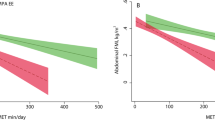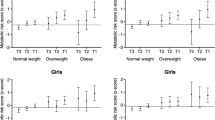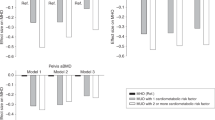Abstract
Background/Objectives:
Adolescents with Down syndrome (DS) exhibit higher levels of fatness and low levels of physical fitness compared with those without DS. In adolescents without DS, fatness is tightly associated with physical fitness, but this association is unclear in adolescents with DS. The aim of this study was to examine the association between several markers of fatness and physical fitness in a relative large sample of adolescents with and without DS.
Subjects/Methods:
A total of 111 adolescents with DS (41 females) aged 11–20 years participated in this cross-sectional study. We also included a sex-matched control group (ratio 1:2) of 222 adolescents without DS aged 12–18 years, participating in the UP&DOWN Study. The Assessing Level of Physical Activity (ALPHA) health-related fitness test battery for adolescents was used to assess fatness and physical fitness.
Results:
Our results show that fatness is not associated with low levels of physical fitness in adolescents with DS (that is, 3 of the 16 analyses identified differences in physical fitness variables by groups of fatness). In contrast, fatness, as expected, is associated with levels of physical fitness in adolescents without DS (that is, 13 of the 16 analyses identified differences in physical fitness variables by groups of fatness).
Conclusions:
The present finding contributes to new knowledge by suggesting that the role of fatness on physical fitness is different in adolescents with and without DS, and consequently, the poor levels of physical fitness in adolescents with DS may be due to the syndrome rather than the high prevalence of obesity from this population.
This is a preview of subscription content, access via your institution
Access options
Subscribe to this journal
Receive 12 print issues and online access
$259.00 per year
only $21.58 per issue
Buy this article
- Purchase on Springer Link
- Instant access to full article PDF
Prices may be subject to local taxes which are calculated during checkout
Similar content being viewed by others
References
World Health Organization World Health Organization Global Strategy on Diet, Physical Activity and Health. Geneva, 2004.
van Gameren-Oosterom HB, van Dommelen P, Schönbeck Y, Oudesluys-Murphy AM, van Wouwe JP, Buitendijk SE . Prevalence of overweight in Dutch children with Down syndrome. Pediatrics 2012; 130: e1520–e1526.
Murray J, Ryan-Krause P . Obesity in children with Down syndrome: background and recommendations for management. Pediatr Nurs 2010; 36: 314–319.
González-Agüero A, Vicente-Rodríguez G, Moreno LA, Guerra-Balic M, Ara I, Casajús JA . Health-related physical fitness in children and adolescents with Down syndrome and response to training. Scand J Med Sci Sports 2010; 20: 716–724.
Pitteti K, Baynard T, Agiovlasitis S . Children and adolescents with Down syndrome, physical fitness and physical activity. J Sport Health Scie 2013; 2: 47–57.
Okely AD, Booth ML, Chey T . Relationships between body composition and fundamental movement skills among children and adolescents. Res Q Exerc Sport 2004; 75: 238–247.
Ortega FB, Ruiz JR, Castillo MJ . Physical activity, physical fitness, and overweight in children and adolescents: evidence from epidemiologic studies. Endocrinol Nutr 2013; 60: 458–469.
Moliner-Urdiales D, Ruiz JR, Vicente-Rodriguez G, Ortega FB, Rey-Lopez JP, España-Romero V et al. Associations of muscular and cardiorespiratory fitness with total and central body fat in adolescents: the HELENA study. Br J Sports Med 2011; 45: 101–108.
Wee SO, Pitteti KH, Goulopoulou, Collier SR, Guerra M, Baynard T . Impact of obesity and Down syndrome on peak heart rate and aerobic capacity in youth and adults. Res Dev Disabil 2015; 36: 198–205.
Ervin RB, Fryar CD, Wang CY, Miller IM, Ogden CL . Strength and body weight in US children and adolescents. Pediatrics 2014; 134: e782–e789.
Fong SS, Lee VY, Chan NN, Chan RS, Chak WK, Pang MY . Motor ability and weight status are determinants of out-of-school activity participation for children with developmental coordination disorder. Res Dev Disabil 2011; 32: 2614–2623.
Lavie CJ, Schutter AD, Archer E, McAuley PA, Blair SN . Obesity and prognosis in chronic diseases—impact of cardiorespiratory fitness in the obesity paradox. Curr Sports Med Rep 2014; 13: 240–245.
Rauch R, Veilleux LN, Rauch F, Bock D, Welisch E, Filler G et al. Muscle force and power in obese and overweight children. J Musculoskelet Neuronal Interact 2012; 12: 80–83.
Castro-Piñero J, Carbonell-Baeza A, Martinez-Gomez D, Gómez-Martínez S, Cabanas-Sánchez V, Santiago C et al. Follow-up in healthy schoolchildren and in adolescents with Down syndrome: psycho-environmental and genetic determinants of physical activity and its impact on fitness, cardiovascular diseases, inflammatory biomarkers and mental health; the UP&DOWN study. BMC Public Health 2014; 14: 400.
Ruiz JR, Castro-Piñero J, España-Romero V, Artero EG, Ortega FB, Cuenca MM et al. Field-based fitness assessment in young people: the ALPHA health-related fitness test battery for children and adolescents. Br J Sports Med 2011; 45: 518–524.
Tejero-Gonzalez CM, Martinez-Gomez D, Bayon-Serna J, Izquierdo-Gomez R, Castro-Piñero J, Veiga OL . Reliability of the ALPHA health-related fitness test battery in adolescents with Down syndrome. J Strength Cond Res 2013; 27: 3221–3224.
Cole TJ, Bellizzi MC, Flegal KM, Dietz WH . Establishing a standard definition for child overweight and obesity worldwide: international survey. BMJ 2000; 320: 1240–1243.
Cole TJ, Flegal KM, Nicholls D, Jackson AA . Body mass index cut offs to define thinness in children and adolescents: international survey. BMJ 2007; 335: 194.
Slaughter MH, Lohman TG, Boileau RA, Horswill CA, Stillman RJ, Van Loan MD et al. Skinfold equations for estimation of body fatness in children and youth. Hum Biol 1998; 60: 709–723.
González-Agüero A, Vicente-Rodríguez G, Ara I, Moreno LA, Casajús JA . Accuracy of prediction equations to assess percentage of body fat in children and adolescents with Down syndrome compared to air displacement plethysmography. Res Dev Disabil 2011; 32: 1764–1769.
Rodríguez G, Moreno LA, Blay MG, Blay VA, Fleta J, Sarría A et al. Body fat measurement in adolescents: comparison of skinfold thickness equations with dual-energy X-ray absorptiometry. Eur J Clin Nutr 2005; 59: 1158–1166.
Fitnessgram. FITNESSGRAM Healthy Fitness Zones. The Cooper Institute: Dallas, TX, 2012.
Savva SC, Tornaritis M, Savva ME, Kourides Y, Panagi A, Silikiotou N et al. Waist circumference and waist-to-height ratio are better predictors of cardiovascular disease risk factors in children than body mass index. Int J Obes Relat Metab Disord 2000; 24: 1453–1458.
Ortega FB, Ruiz JR, Sjöström M . Physical activity, overweight and central adiposity in Swedish children and adolescents: the European Youth Heart Study. Int J Behav Nutr Phys Act 2007; 4: 61.
Castro-Piñero J, Artero EG, España-Romero V, Ortega FB, Sjöström M, Suni J et al. Criterion-related validity of field-based fitness tests in youth: a systematic review. Br J Sports Med 2010; 44: 934–943.
Ruiz JR, Espana-Romero V, Ortega FB, Sjöström M, Castillo MJ, Gutierrez A . Hand span influences optimal grip span in male and female teenagers. J Hand Surg 2006; 31: 1367–1372.
Ortega FB, Artero EG, Ruiz JR, Vicente-Rodriguez G, Bergman P, Hagströmer M et al. Reliability of health-related physical fitness tests in European adolescents. The HELENA Study. Int J Obes 2008; 32: S49–S57.
Baynard T, Pitetti KH, Guerra M, Unnithan VB, Fernhall B . Age-related changes in aerobic capacity in individuals with mental retardation: a 20-yr review. Med Sci Sports Exerc 2008; 40: 1984–1989.
Rimmer JH, Yamaki K, Lowry BM, Wang E, Vogel LC . Obesity and obesity-related secondary conditions in adolescents with intellectual/developmental disabilities. J Intellect Disabil Res 2010; 54: 787–794.
Izquierdo-Gomez R, Martínez-Gómez D, Tejero-Gonzalez CM, Cabanas-Sánchez V, Ruiz Ruiz J, Veiga OL . Are poor physical fitness and obesity two features of the adolescent with Down syndrome? Nutr Hosp 2013; 28: 1348–1351.
Salaun L, Berthouze-Aranda SE . Physical fitness and fatness in adolescents with intellectual disabilities. J Appl Res Intellect Disabil 2012; 25: 231–239.
Foley JT, Harvey S, Chun HJ, Kim SY . The relationships among fundamental motor skills, health-related physical fitness, and body fatness in South Korean adolescents with mental retardation. Res Q Exerc Sport 2008; 79: 149–157.
Li C, Chen S, Meng How Y, Zhang AL . Benefits of physical exercise intervention on fitness of individuals with Down syndrome: a systematic review of randomized-controlled trials. Int J Rehabil Res 2013; 36: 187–195.
González-Agüero A, Vicente-Rodríguez G, Gómez-Cabello A, Ara I, Moreno LA, Casajús JA . A combined training intervention programme increases lean mass in youths with Down syndrome. Res Dev Disabil 2011; 32: 2383–2388.
Izquierdo-Gomez R, Martínez-Gómez D, Villagra A, Fernhall B, Veiga OL, on behalf of the UP&DOWN study group. Associations of physical activity with fatness and fitness in adolescents with Down syndrome: The UP&DOWN study. Res Dev Disabil 2014; 36C: 428–436.
Vasques C, Magalhäes P, Cortinhas A, Mota P, Leitäo J, Lopes VP . Effects of intervention programs on child and adolescencent BMI: a meta-analysis study. J Phys Act Health 2014; 11: 426–444.
Ho M, Garnett SP, Baur L, Burrows T, Stewart L, Neve M et al. Effectiveness of lifestyle interventions in child obesity: systematic review with meta-analysis. Pediatrics 2012; 130: e1647–e1671.
Gutin B, Yin Z, Humphries MC, Barbeau P . Relations of moderate and vigorous physical activity to fitness and fatness in adolescents. Am J Clin Nutr 2005; 81: 746–750.
Moliner-Urdiales D, Ortega FB, Vicente-Rodriguez G, Rey-Lopez JP, Gracia-Marco L, Widhalm K et al. Association of physical activity with muscular strength and fat-free mass in adolescents: the HELENA study. Eur J Appl Physiol 2010; 109: 1119–1127.
Martinez-Gomez D, Ruiz JR, Ortega FB, Casajús JA, Veiga OL, Widhalm K et al. Recommended levels and intensities of physical activity to avoid low-cardiorespiratory fitness in European adolescents: The HELENA study. Am J Hum Biol 2010; 22: 750–756.
Martinez-Gomez D, Ruiz JR, Ortega FB, Veiga OL, Moliner-Urdiales D, Mauro B et al. Recommended levels of physical activity to avoid an excess of body fat in European adolescents: the HELENA Study. Am J Prev Med 2010; 39: 203–211.
Moliner-Urdiales D, Ruiz JR, Ortega FB, Rey-Lopez JP, Vicente-Rodriguez G, España-Romero V et al. Association of objectively assessed physical activity with total and central body fat in Spanish adolescents; the HELENA Study. Int J Obes 2010; 33: 1126–1135.
Acknowledgements
We would like to thank all adolescents with DS, parents and institution collaborators in this study. This study was supported by the DEP 2010-21662-C04-00 grant from the National Plan for Research, Development and Innovation (R+D+i) MICINN.
Author information
Authors and Affiliations
Consortia
Corresponding author
Ethics declarations
Competing interests
The authors declare no conflict of interest.
Appendix
Appendix
UP&DOWN group
Coordinator: Ascension Marcos. Principal Investigators: Ascension Marcos, Oscar L. Veiga, Jose Castro-Piñero, and Fernando Bandrés. Scientific Coordinators: David Martinez-Gomez (chair), Jonatan R. Ruiz (co-chair), Ana Carbonell-Baeza, Sonia Gomez-Martinez, and Catalina Santiago. Spanish National Research Council: Ascension Marcos, Sonia Gomez-Martinez, Esther Nova, Esperanza L. Diaz, Belén Zapatera, Ana M. Veses, Jorge R. Mujico, and Alina Gheorghe. Autonomous University of Madrid: Oscar L. Veiga, H. Ariel Villagra, Juan del-Campo, Carlos Cordente (UPM), Mario Diaz, Carlos M. Tejero, Aitor Acha, Jose M. Moya, Alberto Sanz, David Martinez-Gomez, Veronica Cabanas-Sanchez, Gabriel Rodriguez-Romo (UPM), Rocio Izquierdo-Gomez, Laura Garcia-Cervantes, and Irene Esteban-Cornejo. University of Cadiz: José Castro-Piñero, Jesús Mora-Vicente, José L. González-Montesinos, Julio Conde-Caveda, Francisco B. Ortega (UGR), Jonatan R. Ruiz (UGR), Carmen Padilla Moledo, Ana Carbonell Baeza, Palma Chillón (UGR), Jorge del Rosario Fernández, Ana González Galo, Gonzalo Bellvís Guerra, Álvaro Delgado Alfonso, Fernando Parrilla, Roque Gómez, and Juan Gavala. Complutense University of Madrid: Fernando Bandrés, Alejandro Lucia (UEM), Catalina Santiago (UEM), and Felix Gómez-Gallego (UEM).
Rights and permissions
About this article
Cite this article
Izquierdo-Gomez, R., Martínez-Gómez, D., Fernhall, B. et al. The role of fatness on physical fitness in adolescents with and without Down syndrome: The UP&DOWN study. Int J Obes 40, 22–27 (2016). https://doi.org/10.1038/ijo.2015.164
Received:
Revised:
Accepted:
Published:
Issue Date:
DOI: https://doi.org/10.1038/ijo.2015.164
This article is cited by
-
Associations between domains of physical literacy by weight status in 8- to 12-year-old Canadian children
BMC Public Health (2018)
-
Special Olympics swimming: positive effects on young people with Down syndrome
Sport Sciences for Health (2016)



